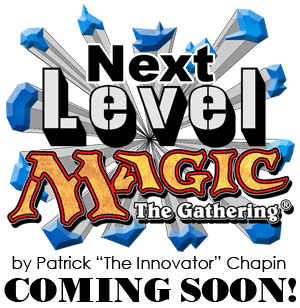
The following are passages from “Next Level Magic,” my Strategy Guide that is being released as an e-book, here on StarCityGames.com, at the end of the month. Each week this month, there will be an excerpt from the book for your enjoyment.
I am contractually obliged to share with you guys some of the letters people have sent in support of my work. We ARE marketing an e-book, after all. Seriously though, I derive more satisfaction out of old friends on the tour, and new friends that read my columns doing well with my help, than just about anything else I do.
“From Mono-Red ten years ago to Five-Color Control today, Patrick Chapin has been instrumental in deck and theory development for years. After a mediocre finish at Pro Tour: Hollywood, Patrick helped me rethink my approach to the Pro Tour, influencing my deck choice for Pro Tour Berlin. In this strategy guide, he shares his years of accumulated knowledge and expertise. Anyone interested in improving their game would do well to check it out!”
– Luis Scott-Vargas
“I decided to take a chance on a Korlash deck designed by Patrick Chapin. I got to (Regionals) and scrambled to get the few cards I needed to complete the deck. About an hour before registration closed, I shuffled up and began testing. After the tournament ended, tiebreakers placed me in second place. Best wishes, and see you at Nationals!”
– Jason
“When I browse on StarCityGames.com, I never miss a chance to check out Patrick’s articles. As the great deckbuilder he is, he always has some insightful comment or some new tech to delight me, making him a much enjoyable read.”
– Guillaume Wafo-Tapa
“Patrick helped me last year with a PTQ I attended by giving me a list before it was posted anywhere on the net. It was the Doran Elemental list he had for the Block season, and it was amazing. Thanks.”
– Anthony
“Patrick is more than a good deck-builder… His writing and teachings help people at every level of the game, and he cracks me up.”
– Gabriel Nassif
“I know a decent amount of good players are over in NY, but that’s a train ticket away. Honestly, that’s part of the reason I decided to message Patrick. I am trying to personally talk to some of the greatest minds in Magic, so I can grow as a player myself. I’ve learned that Magic is a game that you can only learn on your own for so long, and I need to learn from people on a higher level of play in order to reach that level myself. This is one of the biggest reasons I’m really looking forward to Regionals, and by extension Nationals. I appreciate Patrick taking the time to talk to me. I hope to talk to him again in the future, and Ill continue to read the articles weekly… Hell, I’d probably read his articles at this point if he didn’t talk about Magic.”
– Joshua
“In the game of Magic, the player is presented with infinite different plays depending on not only the cards in play, but the cards in your opponent’s hand and deck. To decipher this information, you must use a series of deductive reasoning garnered from your opponent’s play and body language. There are maybe 25 people in the world who currently play the game that can do this at the highest level… Patrick Chapin is one of those people.”
– Mark Herberholz
Semi-Soft Locks
Broodmate Dragon, Ajani Vengeant, Cruel Ultimatum. These are the types of cards that can be the center of Constructed decks (not to mention if we are fortunate enough to draft them…). They have game-changing effects that have the potential to essentially “win the game” all by themselves.

Sometimes, merely playing a card like Broodmate Dragon can be enough to turn around a game where you were greatly behind. Typically, if you are in any sort of reasonable shape, playing something like Cruel Ultimatum will lock the game up for you, if unanswered.
Many people call these cards “bombs,” but that term is a little vague. What does it mean for a card to be a bomb? One obvious guess is to say that “bombs” are really strong Magic cards. However, this misses the point. Incinerate is a strong Magic card, but to call it a bomb is a bit of a stretch. What are we really talking about when we are talking about bombs?
Typically, when someone talks about a bomb, what they are talking about is a card that single-handedly acts as a semi-soft lock.
To understand a semi-soft lock, we will first look at the idea of a soft lock in general. A soft lock is a term used to describe a game state where one player is essentially assured victory due to the inability of an opponent to beat a particular feature of the game.
To “lock up” a game of Magic is to create a situation where the opponent cannot win (ensuring your victory). A hard lock is when your opponent ABSOLUTELY cannot win. For instance, if you have Trinisphere, Crucible of Worlds, and Strip Mine, you could actually create a game state where your opponent absolutely could not win (assuming their deck is not full of Simian Spirit Guides, etc). Remember, it is not relevant if a way out exists, but merely if your opponent has a way out.
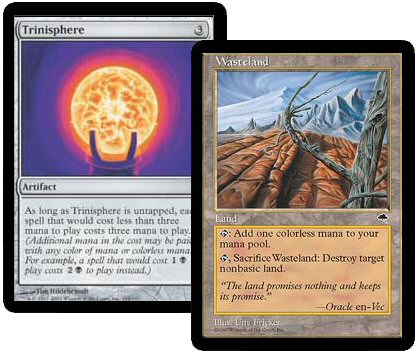
This is not to say that the only locks are ones where opponents can’t cast spells. If you have Voltaic Key and Time Vault in play, you can create a situation where you are taking all of the turns. The point is that if you are assured victory, you have the game locked up.
A soft lock is when you create a game state where the opponent probably can’t beat you. For instance, Trinisphere plus Wasteland is a soft lock against a Storm combo deck in Vintage. If you play a Trinisphere, they probably can’t beat you. They have “outs,” but it will probably beat them, and it will beat them if unchecked.
A semi-soft lock is a card or set of conditions that generally “wins the game” by itself against some strategies. This is not to say that it will always win the game for you, but rather that playing this card successfully tends to translate into a victory against many opponents.
For instance, Broodmate Dragon is a semi-soft lock against White decks in Standard, or at least it was prior to Alara Reborn. As of early 2009, Standard is dominated by Cryptic Command and Spectral Procession decks. Broodmate Dragon will usually be enough of a game-swinging card to win most games against Spectral Procession decks. We will talk more about semi-soft locks later in this guide. For the time being, think of them as a play that tries to gain a game-winning advantage.
This concept is useful when building decks, particularly bold new decks that do not fit into some cookie-cutter mold for an existing archetype or popular deck. When you are considering building a new deck, one of the questions to ask yourself is what semi-soft locks your deck is aiming for, or capable of achieving.
For instance, let’s say determine that a given format is such that playing Voices from the Void on your opponent for at least four cards will usually turn into a victory against most of the decks in that format. When building your “Voices from the Void” deck, you can imagine the playing of this “Semi-Soft Lock” and what events lead up to it, as well as how the game will progress from there. By looking at what Voices from the Void beats and what it does not beat, you can start uncovering the road map that will lead you to the deck that you are trying to build.
When you look at what cards like Cryptic Command, Esper Charm, and Cruel Ultimatum beat on their own, you quickly realize that a deck based on them is going to be inherently strong against most creature decks. This lets you know that you can add a few more cards like Jace to strengthen other match-ups.
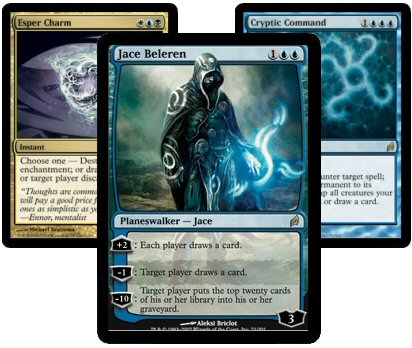
Many Cruel Ultimatum decks are set up as an elaborate system of surviving long enough to “lock” out the opponent with an Ultimatum (or even a Broodmate, Jace, or Wall of Reverence depending on the match-up). When building such a deck, it is not just enough to ask what your semi-soft lock beats… You must also ask yourself what it does not beat. For instance, Cruel Ultimatum often does not beat tokens, Broodmate Dragon doesn’t beat Five-Color Control, and Jace doesn’t beat Kithkin.
It was because we realized that our inherent strategy doesn’t beat Faeries that we were able to reach conclusions such as the importance (at the time) of Broken Ambitions, Volcanic Fallout, Plumeveil, and Terror. Imagining what would beat the things that our semi-soft lock doesn’t beat helped us arrive at the right mix of control cards, and avoid traps like Rhox War Monk, Bant Charm, Tidings, Firespout, Oona, Condemn, and Story Circle.
From here, you ask yourself how you got to the position that would allow you to win with this card or line of play, and imagine what it would take to set it all up. This is how you determine things like Broken Ambitions, Wall of Reverence, and the right mix of defensive cards to buy you the time you need to survive. Black/White Tokens is on the rise? If you think you need to sweep the board by turn 4, maybe there needs to be more sweepers added to the deck, such as Cloudthresher or Wrath of God.
From here, you imagine what the game will look like moving forward. Cruel Ultimatum usually takes care of itself. However, a Broodmate Dragon is a much harder lock if you save a Cryptic Command to use as a “Fog” to get in that extra attack step….
Semi-soft locks are far from the only way to win games of Magic. Not every strategy revolves around playing “bombs,” or even “bombs plus support spells.” While some strategies focus on playing “good cards” (cards that are good on their own), other strategies are more interested in synergy.
Semi-soft locks don’t have to be only high-casting-cost cards. Tarmogoyf, Dark Confidant, and Wild Nacatl can create such an impact on the game, due to their own raw power level, that you can literally just overpower the opponent. A hallmark of cards like this is that they create effects that are stronger than what you paid for. You should not be able to get this much for so little mana, and as a result, sometimes merely playing these cards on the first or second turn can dramatically increase your win percentage against many opponents.
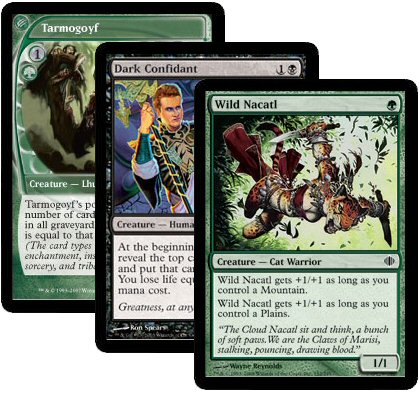
These are three of the ten best creatures of all time, all because they cost less than they should.
Goblin Lackey, Arcbound Ravager, and Narcomoeba are excellent examples of cards that get their strength from synergy as opposed to raw power. These three creatures are also undisputedly among the Top 10 most powerful creatures in the history of the game. Still, none of these creatures is particularly impressive without the proper context.
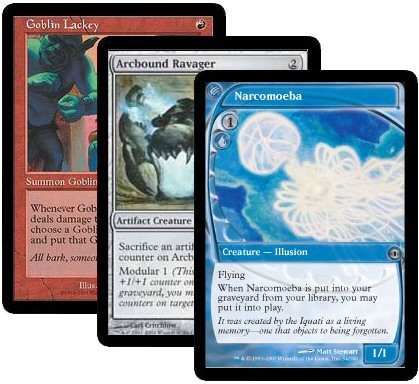
The key is that cards like this scale in power proportionate to how extreme you take a certain theme. Goblin Lackey scales with the amount of Goblins you play. Ravager grows stronger the more artifacts you play, obviously. Narcomoeba’s strength is proportionate to how much you are milling yourself in relation to how often you actually draw cards.
Each of these themes can be taken to an absurd degree, where essentially your entire deck is focused on exploiting them. Once you are dedicated to playing all Goblins, Artifacts, or Graveyard cards, cards that are benefited by these “linears” begin to reach awesome levels of power.
We want to look for these kinds of synergies, as well as cards that are just undercosted (create a stronger effect that what you pay for) when building decks from the “Top Down” perspective.
When you see cards like Goblin Lackey or Arcbound Ravager or Narcomoeba, it is logical to see how far you can extend the themes that accentuate these cards’ power levels. This is a form of Top Down design. You have the card that suggests a linear. You build from the Top (the card that rewards you for this) Down (towards the cards that logically fit with this theme).
Similarly, if you start with cards like Dark Confidant or Tarmogoyf or Wild Nacatl, you can build around them in Top Down fashion as well. The primary philosophy behind Zoo decks is that they are just aggro decks that use all the best cards. You start from the Top (the most powerful creatures in the format are Tarmogoyf, Dark Confidant, Wild Nacatl…) and work Down from there (Lightning Helix, Tribal Flames, and Fetchlands provide the most logical support cards, etc).
If you combine “seeing the big picture” with brainstorming by asking “What do I already know about this situation that is good/powerful/useful/working?” then you are starting to describe what is meant by Top Down thinking. This is 80% of the battle.
Still, 80% is 20% short of perfect. Good is the enemy of great. Therefore, you’d better make sure you don’t stop at Big Picture Thinking. Just because you realize that Reflecting Pool and Vivid Creek form an unbelievable manabase that allows a control deck to play whatever cards it wants, doesn’t mean that Wizards of the Coast should just skip straight to sending you the prize checks.
It is not enough to know that Reflecting Pool and Vivid Creek enable you to play all the best control cards. We want to know what exact deck will give us the best chances to win. This is why we don’t stop after our Top Down thinking…
Patrick Chapin
“The Innovator”

